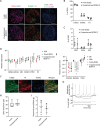Cryopreservation of Induced Pluripotent Stem Cell-Derived Dopaminergic Neurospheres for Clinical Application
- PMID: 34958047
- PMCID: PMC9108593
- DOI: 10.3233/JPD-212934
Cryopreservation of Induced Pluripotent Stem Cell-Derived Dopaminergic Neurospheres for Clinical Application
Abstract
Background: Pluripotent stem cell (PSC)-derived dopaminergic (DA) neurons are an expected source of cell therapy for Parkinson's disease. The transplantation of cell aggregates or neurospheres, instead of a single cell suspension has several advantages, such as keeping the 3D structure of the donor cells and ease of handling. For this PSC-based therapy to become a widely available treatment, cryopreservation of the final product is critical in the manufacturing process. However, cryopreserving cell aggregates is more complicated than cryopreserving single cell suspensions. Previous studies showed poor survival of the DA neurons after the transplantation of cryopreserved fetal ventral-mesencephalic tissues.
Objective: To achieve the cryopreservation of induced pluripotent stem cell (iPSC)-derived DA neurospheres toward clinical application.
Methods: We cryopreserved iPSC-derived DA neurospheres in various clinically applicable cryopreservation media and freezing protocols and assessed viability and neurite extension. We evaluated the population and neuronal function of cryopreserved cells by the selected method in vitro. We also injected the cells into 6-hydroxydopamine (6-OHDA) lesioned rats, and assessed their survival, maturation and function in vivo.
Results: The iPSC-derived DA neurospheres cryopreserved by Proton Freezer in the cryopreservation medium Bambanker hRM (BBK) showed favorable viability after thawing and had equivalent expression of DA-specific markers, dopamine secretion, and electrophysiological activity as fresh spheres. When transplanted into 6-OHDA-lesioned rats, the cryopreserved cells survived and differentiated into mature DA neurons, resulting in improved abnormal rotational behavior.
Conclusion: These results show that the combination of BBK and Proton Freezer is suitable for the cryopreservation of iPSC-derived DA neurospheres.
Keywords: Cryopreservation; Parkinson’s disease; cell-based therapy; dopaminergic neuron; induced pluripotent stem cells; neurosphere.
Figures






Similar articles
-
Cryopreservation Maintains Functionality of Human iPSC Dopamine Neurons and Rescues Parkinsonian Phenotypes In Vivo.Stem Cell Reports. 2017 Jul 11;9(1):149-161. doi: 10.1016/j.stemcr.2017.04.033. Epub 2017 Jun 1. Stem Cell Reports. 2017. PMID: 28579395 Free PMC article.
-
Improved cell therapy protocols for Parkinson's disease based on differentiation efficiency and safety of hESC-, hiPSC-, and non-human primate iPSC-derived dopaminergic neurons.Stem Cells. 2013 Aug;31(8):1548-62. doi: 10.1002/stem.1415. Stem Cells. 2013. PMID: 23666606 Free PMC article.
-
Grafts Derived from an α-Synuclein Triplication Patient Mediate Functional Recovery but Develop Disease-Associated Pathology in the 6-OHDA Model of Parkinson's Disease.J Parkinsons Dis. 2021;11(2):515-528. doi: 10.3233/JPD-202366. J Parkinsons Dis. 2021. PMID: 33361611 Free PMC article.
-
Stem cell therapy for Parkinson's disease.Ernst Schering Res Found Workshop. 2006;(60):229-44. doi: 10.1007/3-540-31437-7_15. Ernst Schering Res Found Workshop. 2006. PMID: 16903426 Review.
-
Allogenic transplantation therapy of iPS cell-derived dopamine progenitors for Parkinson's disease -Current status of the Kyoto Trial and future perspectives.Parkinsonism Relat Disord. 2025 Jun;135:107833. doi: 10.1016/j.parkreldis.2025.107833. Epub 2025 Apr 19. Parkinsonism Relat Disord. 2025. PMID: 40307147 Review.
Cited by
-
Optimizing cryopreservation strategies for scalable cell therapies: A comprehensive review with insights from iPSC-derived therapies.Biotechnol Prog. 2024 Nov-Dec;40(6):e3504. doi: 10.1002/btpr.3504. Epub 2024 Sep 13. Biotechnol Prog. 2024. PMID: 39268839 Free PMC article. Review.
-
Robust Generation of Ready-to-Use Cryopreserved Motor Neurons from Human Pluripotent Stem Cells for Disease Modeling.Int J Mol Sci. 2022 Nov 3;23(21):13462. doi: 10.3390/ijms232113462. Int J Mol Sci. 2022. PMID: 36362259 Free PMC article.
-
Somatic cell reprogramming for Parkinson's disease treatment.Ibrain. 2025 Jan 4;11(1):59-73. doi: 10.1002/ibra.12189. eCollection 2025 Spring. Ibrain. 2025. PMID: 40103698 Free PMC article. Review.
-
Long-Term Evaluation of Intranigral Transplantation of Human iPSC-Derived Dopamine Neurons in a Parkinson's Disease Mouse Model.Cells. 2022 May 10;11(10):1596. doi: 10.3390/cells11101596. Cells. 2022. PMID: 35626637 Free PMC article.
-
Cryopreservation practices in clinical and preclinical iPSC-based cell therapies: Current challenges and future directions.Biotechnol Prog. 2025 Jul-Aug;41(4):e70031. doi: 10.1002/btpr.70031. Epub 2025 Apr 2. Biotechnol Prog. 2025. PMID: 40171754 Free PMC article. Review.
References
-
- Nolbrant S, Heuer A, Parmar M, Kirkeby A (2017) Generation of high-purity human ventral midbrain dopaminergic progenitors for in vitro maturation and intracerebral transplantation. Nat Protoc 12, 1962–1979. - PubMed
-
- Kikuchi T, Morizane A, Doi D, Magotani H, Onoe H, Hayashi T, Mizuma H, Takara S, Takahashi R, Inoue H, Morita S, Yamamoto M, Okita K, Nakagawa M, Parmar M, Takahashi J (2017) Human iPS cell-derived dopaminergic neurons function in a primate Parkinson’s disease model. Nature 548, 592–596. - PubMed
-
- Kim TW, Piao J, Koo SY, Kriks S, Chung SY, Betel D, Socci ND, Choi SJ, Zabierowski S, Dubose BN, Hill EJ, Mosharov E V., Irion S, Tomishima MJ, Tabar V, Studer L (2021) Biphasic activation of WNT signaling facilitates the derivation of midbrain dopamine neurons from hESCs for translational use. Cell Stem Cell 28, 343–355.e5. - PMC - PubMed

